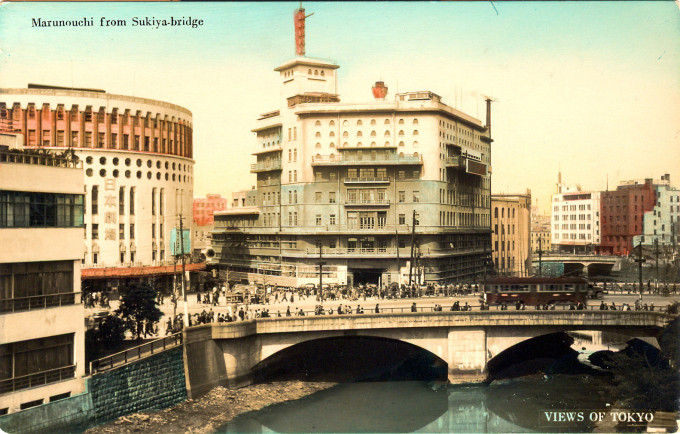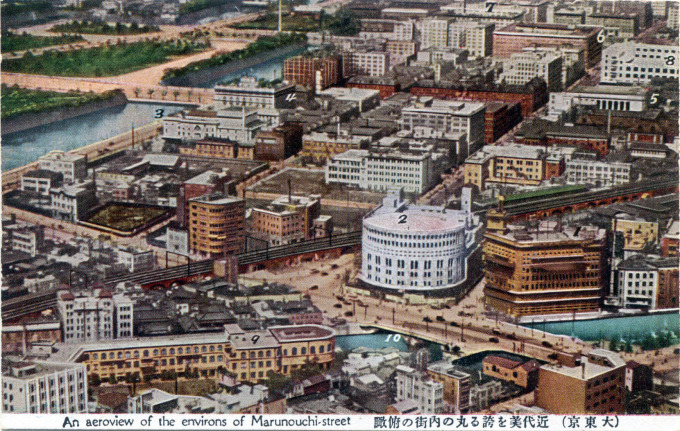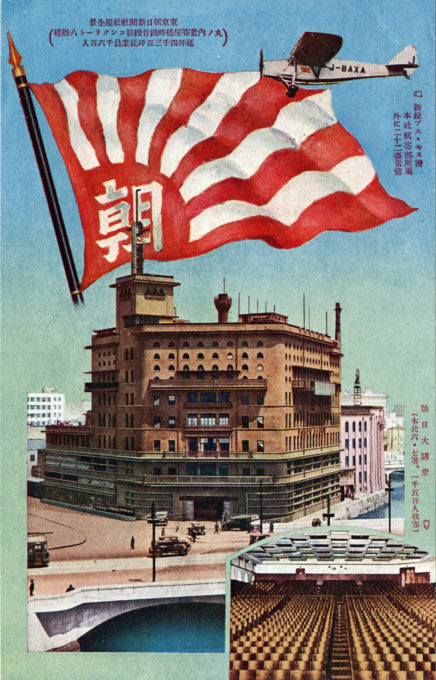
The Asahi Shimbun [Newspaper] building, at Sukiyabashi, Tokyo, c. 1930. To its left is the Nichigeki Theater. At the extreme left is the Tamei Elementary School.
See also:
Asahi Shimbun Building, c. 1930
Sukiyabashi, c. 1910
Aerial Views of Tokyo, c. 1930-1940
Tokyo-London World Record Flight, 1937
“[O]utstanding buildings continued to concentrate near bridges even after the 1930s, as if to capture the story of these spaces for themselves; the result, as we have seen, is the bridgeside plaza.
“… From this perspective the great architectural masterpiece of Tokyo has to be the urban in and around Sukiyabashi Bridge. During the decade or so following the earthquake, beautiful buildings representing the period’s most innovative designs – from secessionist to something approaching international style – appeared along the canal. Facing the bridgeside plaza were the Asashi Shimbunsha (completed in 1927) and Nichigeki Theater buildings. Behind them stood the Hogaku-za Theater, and across the bridge, adjoining a small park, was the Tamei Elementary School.
“Together they made a splendid urban space. Rather than assert a powerful individual monumentality, these architectural recipients of modernist baptism seemed to have sought a collective effect in the context of the locale as a whole, to intensify the completion of the urban space as a plaza.”
– Tokyo: a Spatial Anthropology, by Hidenobu Jinnai, 1995
From the wiki: “One of Japan’s oldest and largest national daily newspapers, the Asahi Shimbun began publication in Osaka on 25 January 1879 as a small-print, four-page illustrated paper that sold for one sen (1/100th of a yen) a copy, and had a circulation of approximately 3,000 copies. On 10 July 1888, the first issue of the Tokyo Asahi Shimbun was published from the Tokyo office at Motosukiyachō, Kyōbashi. In 1908, Osaka Asahi Shimbun and Tokyo Asahi Shimbun were merged into a single unified corporation. In 1918, because of its critical stance towards Terauchi Masatake’s cabinet during the Rice Riots, government authorities suppressed an article in the Osaka Asahi, leading to a softening of its liberal views, and the resignation of many of its staff reporters in protest. Indeed, the newspaper’s liberal position led to its vandalization during the February 26 Incident of 1936, as well as repeated attacks from the right wing throughout this period.
“On 9 April 1937 the Kamikaze, a Mitsubishi aircraft sponsored by the Asahi Shimbun company and flown by Masaaki Iinuma, arrived in London, to the astonishment of the Western world. It was the first Japanese-built aircraft to fly to Europe.”

Above: Aerial view of Sukiyabashi, Yurakucho and the Marunouchi business district, c. 1940. The white semi-circular building at center (#2) is the Nichgeki Theater. To its left is the Asahi Shimbun building. At lower-left (#9) is Tamei Elementary School.



Pingback: Aerial Views of Tokyo, c. 1940. | Old Tokyo
Pingback: Sukiyabashi, c. 1910. | Old Tokyo
Pingback: Asahi Shimbun Building, c. 1930. | Old Tokyo